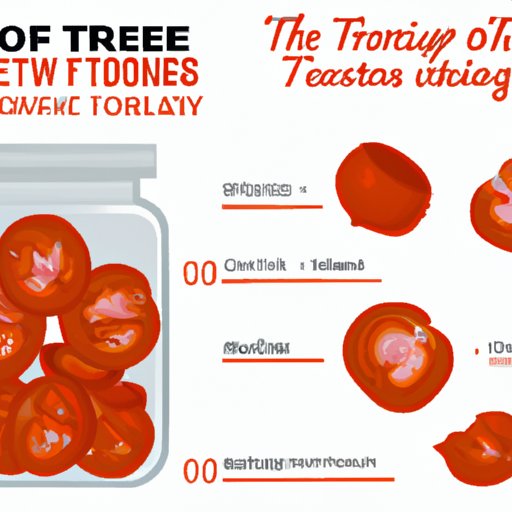Introduction
Tomatoes are a staple in many kitchens, adding flavor and nutrition to a wide range of dishes. However, they can go bad quickly, leaving you with a pile of mushy, rotting tomatoes and a disappointingly empty wallet. Freezing tomatoes offers an easy and budget-friendly way to stock up on this versatile fruit while reducing food waste and preserving their nutritional value.
Step-by-Step Guide
Before freezing your tomatoes, there are a few preparation steps to follow. First, choose the best type of tomatoes for freezing. Plum, Roma, or other meaty tomatoes work well, while larger, juicier tomatoes may become mushy when frozen. Avoid bruised or overripe tomatoes, as their quality may decline even further during the freezing process.
To prepare your tomatoes for freezing, start by washing and drying them thoroughly. Remove the stem and cut away any blemishes or spots. Depending on your preference, you may choose to leave your tomatoes whole or slice them into pieces.
Next, blanch your tomatoes in boiling water for about 30 seconds. This will help loosen their skins and make them easier to peel. Once blanched, transfer your tomatoes to an ice bath to stop the cooking process. Peel the skins off carefully using a sharp knife or your fingers.
Now you’re ready to freeze your tomatoes. You may choose to freeze them whole or cut them into smaller pieces, depending on your needs. Place your tomatoes in airtight containers or freezer bags, removing as much air as possible before sealing. Label your containers or bags with the date and contents, then store them in the freezer.
Recipe Roundup
Frozen tomatoes can be used in a wide range of dishes, from stews and soups to sauces and more. One popular use for frozen tomatoes is as a base for marinara sauce. Simply thaw your frozen tomatoes and blend them in a food processor, then simmer them in a pot with garlic, onion, and herbs until they thicken into a rich, flavorful sauce.
You may also choose to freeze diced tomatoes in convenient portions for use as a condiment or ingredient in your favorite recipes. Frozen diced tomatoes can be added directly to soups, stews, or chili without thawing, adding rich flavor and a burst of nutrition to your meals.
Preservation Tips
Frozen tomatoes can last up to 6 months in the freezer without losing their flavor or nutritional value. However, it’s important to follow proper storage guidelines and discard any tomatoes that show signs of spoilage. Always store your frozen tomatoes in airtight containers or freezer bags, removing as much air as possible before sealing. If using containers, choose ones that are made for freezer storage to prevent freezer burn.
To ensure you’re using your oldest frozen tomatoes first, label each container or bag with the date and contents. You may also choose to divide your tomatoes into individual portions before freezing, so you can easily grab the amount you need for a specific recipe without thawing extra.
Comparative Analysis
There are several methods for freezing tomatoes, each with its own pros and cons. Ziplock bags are convenient and affordable, but may allow air to seep in and cause freezer burn over time. Plastic containers offer better protection against freezer burn, but may take up more space in your freezer. Vacuum sealing is the most effective option for preventing freezer burn, but may be too expensive for some budgets.
Ultimately, the best freezing method depends on your personal preferences and practical considerations. If you have limited space or need to freeze small portions, bags may be the best option. If you have more room and want to ensure maximum protection, plastic containers or vacuum sealing may be the way to go.
Money-Saving Strategies
Buying fresh tomatoes in bulk during peak season is one of the easiest ways to save money on produce and reduce waste. However, it’s important to properly prepare your fresh tomatoes to ensure they last as long as possible. Store them in a cool, dry place with good ventilation, and avoid storing them in the fridge, which can cause them to become mealy or lose flavor. You may also choose to freeze fresh tomatoes whole, then prepare them for use later.
Health and Nutrition
Tomatoes are loaded with beneficial nutrients, including vitamin C, potassium, and lycopene, a powerful antioxidant. Freezing tomatoes can help preserve their nutritional value, making it easy to add them to a healthy and balanced diet year-round. To prevent losing nutrients during the freezing process, it’s best to blanch your tomatoes before freezing to deactivate enzymes that can break down their nutritional value over time.
Conclusion
Freezing tomatoes is an easy and cost-effective way to preserve fresh produce, reduce food waste, and enjoy the benefits of this flavorful and nutritious fruit year-round. By following these simple steps and utilizing the recipes and tips provided, you can make the most of your tomatoes without having to worry about spoilage or excess waste.
